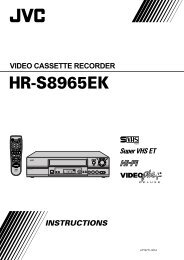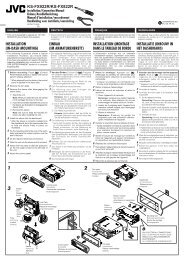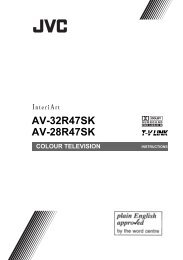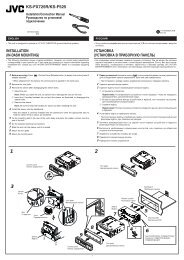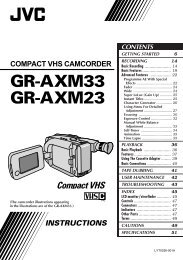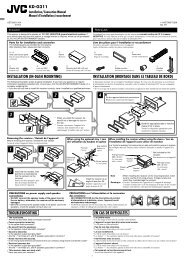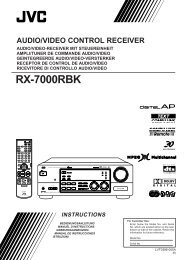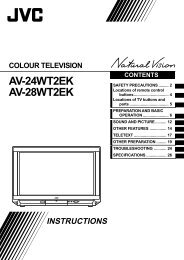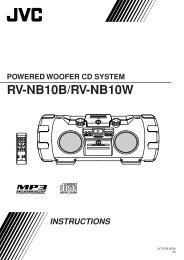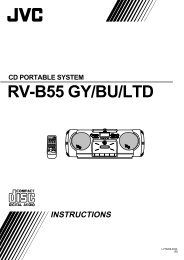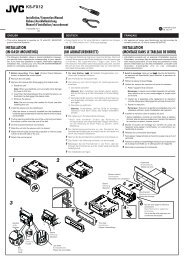Create successful ePaper yourself
Turn your PDF publications into a flip-book with our unique Google optimized e-Paper software.
7 DAP (Digital Acoustic Processor) modes<br />
DAP modes have been designed to create important<br />
acoustic surround elements.<br />
The sound heard in a live club, dance club, hall or pavilion<br />
consists of direct sound and indirect sound—early reflections<br />
and reflections from behind. Direct sounds reach the listener<br />
directly without any reflection. On the other hand, indirect<br />
sounds are delayed by the distances of the ceiling and walls<br />
(see the diagram below).<br />
These indirect sounds are important elements of the acoustic<br />
surround effects. The DAP mode can reproduce a realistic<br />
sound field by adding these indirect sounds.<br />
The following DAP modes are provided with this system.<br />
LIVE CLUB: Gives the feeling of a live music club with a<br />
low ceiling.<br />
DANCE CLUB: Gives a throbbing bass beat.<br />
HALL:<br />
PAVILION:<br />
Gives clear vocal and the feeling of a<br />
concert hall.<br />
Gives the spacious feeling of a pavilion with<br />
a high ceiling.<br />
These DAP modes can be used to add the acoustic surround<br />
effects while reproducing 2 channel stereo software, either<br />
analog or Linear PCM, and can give you a real “being there”<br />
feeling.<br />
• When one of the DAP modes is selected, the DSP indicator<br />
lights up on the display window.<br />
Early reflections<br />
Creating sound field<br />
Reflections from behind<br />
7 All Channel Stereo<br />
All Channel Stereo (ALL CH ST.) mode can reproduce a<br />
larger stereo sound field using all the connected (and<br />
activated) speakers.<br />
All Channel Stereo can be used while reproducing 2 channel<br />
stereo software, either analog or Linear PCM.<br />
• When All Channel Stereo is selected, the DSP indicator<br />
lights up on the display.<br />
7 The signal indicators on the display window<br />
Light up to indicate the incoming signals.<br />
L: Lights up when the left channel signal comes in.<br />
C: Lights up when the center channel signal comes in.<br />
R: Lights up when the right channel signal comes in.<br />
LFE: Lights up when the LFE channel signal comes in.<br />
LS: Lights up when the left surround channel signal<br />
RS:<br />
All Channel Stereo reproduction<br />
Normal stereo sound<br />
L C R<br />
LFE<br />
LS S RS<br />
All channel stereo<br />
comes in.<br />
Lights up when the right surround channel signal<br />
comes in.<br />
S: Lights up when the monaural rear channel signal or 2<br />
channel Dolby Surround signal comes in.<br />
Direct sounds<br />
Available Surround modes for each input signal<br />
‡: Possible / ×: Impossible<br />
Mode SURROUND DOLBY DTS PLII PLII LIVE DANCE HALL PAVILION ALL CH<br />
Signals OFF (stereo) DIGITAL SURROUND MOVIE MUSIC CLUB CLUB ST.<br />
Dolby Digital<br />
(Multichannel)<br />
‡ ‡ × × × × × × × ×<br />
Dolby Digital<br />
(2 channel)<br />
‡ × × ‡ ‡ × × × × ×<br />
DTS Digital<br />
Surround ‡ × ‡ × × × × × × ×<br />
(Multichannel)<br />
DTS Digital<br />
Surround ‡ × × ‡ ‡ × × × × ×<br />
(2 channel)<br />
Analog<br />
(AUX/FM/AM)<br />
or<br />
‡ × × ‡ ‡ ‡ ‡ ‡ ‡ ‡<br />
Linear PCM<br />
38


![TH-V70R[B] revision - JVC](https://img.yumpu.com/23738839/43/500x640/th-v70rb-revision-jvc.jpg)
